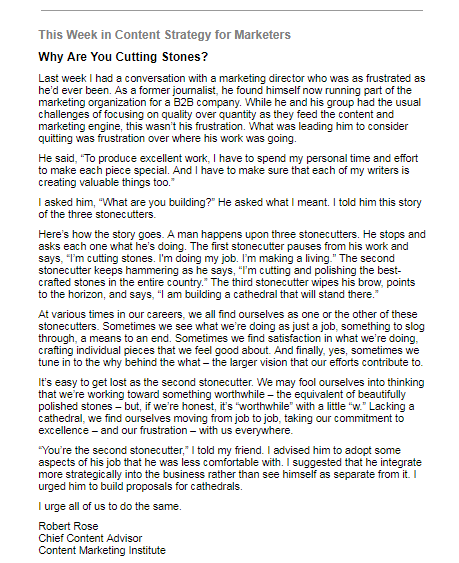Author: Marcia Riefer Johnston / Source: Content Marketing Institute

Week after week since January 2015, CMI has sent a Content Strategy for Marketers e-newsletter written by CMI Chief Strategy Advisor Robert Rose. In this newsletter, Robert delivers marketing insights through a zen sensibility, leaving many of us inspired as businesspeople and as people. (Since December, the Content Strategy Newsletter merged with the weekly newsletter, bringing Robert’s thoughts to even more subscribers.)
Every year I highlight some of my favorite messages from this newsletter to give subscribers a second chance to savor some of Robert’s insights while giving everyone else a taste of what they’ve missed.
I hope this year’s post gives you an opportunity to step back from the demands of your job and rekindle your enthusiasm for (dare I say meditate on?) what this marketing business is all about – or could be.
1. Take the long view of your job
When I refer to Robert’s sensibility as “zen” (lowercase “z”), I’m talking about, for one thing, an inclination to take the long view. When marketers come up against frustrations, for example, Robert has a way of reframing their situations in such a way that new opportunities – for the individual and for the company – emerge.
For example, in the Why Are You Cutting Stones? (October 7, 2017) edition, Robert relates his conversation with a marketing director who was considering quitting his job. After putting everything he had into working with his team to create excellent content, he was left “frustrated over where his work was going.”

Robert told him the story of the three stonecutters, all doing the same work. When asked what they were doing, the first said he was making a living. The second said he was cutting and polishing “the best-crafted stones in the entire country.” The third declared he was building a cathedral.
“You’re the second stonecutter,” Robert told the marketing director.
I advised him to adopt some aspects of his job that he was less comfortable with. I suggested that he integrate more strategically into the business rather than see himself as separate from it. I urged him to build proposals for cathedrals.
Robert urges all of us to do the same: set our sights way out. When we lack a cathedral to build, we may “find ourselves moving from job to job, taking our commitment to excellence – and our frustration – with us everywhere.” He suggests we “tune in to the why behind the what – the larger vision that our efforts contribute to.”
What are you building?
2. Promote the difference that marketers make in the world
Robert looks beyond “what’s in it for me?” to “what’s in it for all of us?”
In the How Well Does Your Marketing Sell Marketing? (September 30, 2017) newsletter, he addresses the difficulty many marketing departments have finding talented people to hire for their content teams. He cites research showing college students increasingly want meaningful careers – and they don’t see marketing as one of those.

He encourages marketers to band together to convey the value of the profession:
To compete for the new marketing talent, we need to promote the meaning of what we do, not the tactics of how we do it. We need to … express the creativity and wisdom that content creators, editors, and producers bring to our business. Yes, we marketers wear many hats. We create ads, we run A/B tests, we optimize keyword strategies, and we implement content management technology. But if we don’t talk about the meaning behind those activities – the difference that all our efforts make in the world – we risk mechanizing the soul right out of the story we are trying to tell.
Robert closes his plea for camaraderie thus: “Marketing itself, as a worthy career, may turn out to be one of the most important things we sell.”
Are you in?
3. Unfetter your thinking before you make editorial plans
Just as a zen mindset enables us to discern and remove the artificial limitations we’ve placed on ourselves, Robert proposes that we unfetter our thinking when we put together editorial plans so…
Audience Team
The digital audience insights you need to build, manage and market to your digital audiences.

